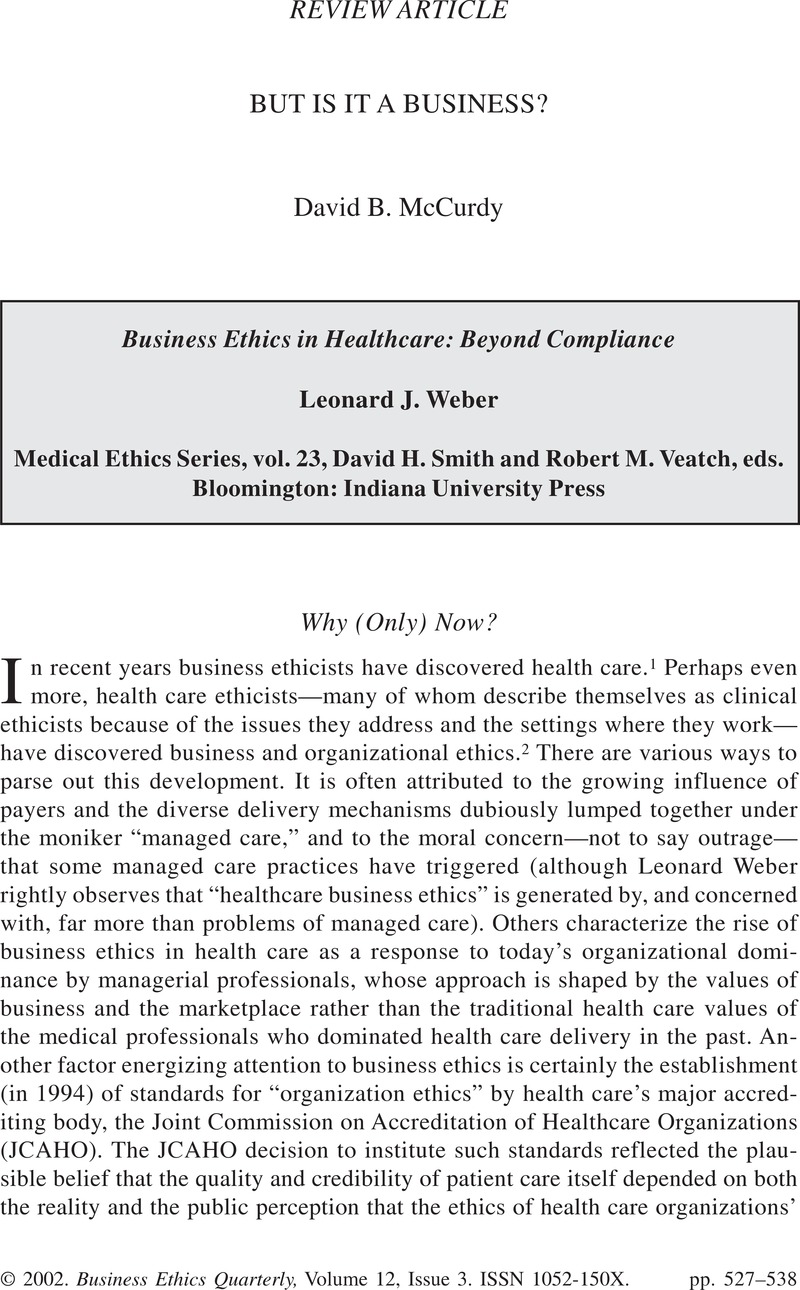No CrossRef data available.
Article contents
But is it a Business?
Published online by Cambridge University Press: 23 January 2015
Abstract

- Type
- Review Articles
- Information
- Copyright
- Copyright © Society for Business Ethics 2002
References
Notes
1 For an early example, see Patricia Werhane, “The Ethics of Health Care as a Business,” Business & Professional Ethics Journal 9 (1991), nos. 3 and 4: 7–20; reprinted in Health Care Ethics: Critical Issues for the 21st Century, ed. David C. Thomasma and John E. Monagle (Gaithersburg, Md.: Aspen Publishers, 1998), 505–512.
2 Weber’s book constitutes an example of the latter.
3 Paul M. Schyve, “Patients Rights and Organization Ethics: The Joint Commission Perspective,” Bioethics Forum 12, no. 2: 13–20.
4 The Society for Clinical Ethics, one precursor to today’s American Society for Bioethics and Humanities, was formed in 1986.
5 Margarete Arndt and Barbara Bigelow, “Reengineering: Deja Vu All Over Again,” Health Care Management Review 23, no. 3 (Summer 1998): 64.
6 See Angela Schneider-O’Connell and David B. McCurdy, “Translating Values into Operational Standards: A Case in Health Care,” in From the Universities to the Marketplace: Proceedings of the Third International Conference Promoting Business Ethics, second of three diskettes (Niagara Falls, N.Y.: Vincentian Universities in the United States, 1996–97).
7 In Weber’s book “healthcare” always appears as one word.
8 Weber’s maxim also happens to be part of the title of a well-known essay about health care ethics committees and consultation (Howard Brody, “Applied Ethics: Don’t Change the Subject,” in Clinical Ethics: Theory and Practice, ed. B. Hoffmaster, B. Freedman, and F. Raser [Clifton, N.J.: 1990], 183–200).
9 See Stanley Joel Reiser, “The Ethical Life of Health Care Organizations,” Hastings Center Report 24, no. 6 (November-December 1994): 28–35.
10 H. Newton Malony, Living with Paradox: Religious Leadership and the Genius of Double Vision (San Francisco: Jossey-Bass, 1998), 76.
11 Ibid., 84, 86.
12 Ibid., 1–8.
13 On “living with paradox,” Malony cites James Collins and Jerry Porras, Built to Last: Successful Habits of Visionary Companies (New York: HarperCollins, 1994). In analyzing the success of exemplary corporate leaders, these authors claim that the key skill of both- and leadership is not the ability to strike a balance or reach a compromise between the two poles of the paradox; rather it is the ability to value both sides of the paradox, to see the truth of both at the same time—“the skill of double vision” (Malony, p. 7).
14 John Hasnas, “The Normative Theories of Business Ethics: A Guide for the Perplexed,” Business Ethics Quarterly 8, no. 1 (1998): 19–42.
15 On this relationship, see Schyve, “Patient Rights and Organization Ethics: The Joint Commission Perspective,” 13–20.
16 For a vigorous argument for assigning responsibility to individuals and a critique of the concept of organizational responsibility, see Van Rensselaer Potter, “Individuals Bear Responsibility,” Bioethics Forum 12, no. 2 (1996): 27–28.
17 Kenneth E. Goodpaster and John B. Matthews, Jr., “Can a Corporation Have a Conscience?” Harvard Business Review 60, no. 1 (1982): 132–141.


